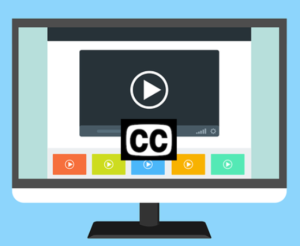
In today’s digital era, accessibility plays a pivotal role in ensuring equal opportunities for everyone. While web designers and developers have made significant strides in creating inclusive user experiences, it’s important to explore and promote the use of captions with semantic markup as a means to enhance accessibility for individuals with hearing impairments. Captions not only benefit those with hearing disabilities but also contribute to a more inclusive society. In this blog post, we will delve into the importance of captions and discuss how semantic markup can be used to promote digital products that prioritize accessibility.
The Importance of Captions

For individuals with hearing disabilities, captions serve as a vital means of communication, enabling them to fully engage with audiovisual content. Captions provide a textual representation of spoken words, sound effects, and relevant audio information. They not only facilitate understanding of the content but also enhance the overall user experience. By incorporating captions, digital products become more inclusive and cater to a wider audience.
What is captions quality and how to ensure it?
Caption quality refers to the accuracy, readability, and synchronization of captions with the audiovisual content. Ensuring high caption quality is essential for individuals with hearing disabilities to fully comprehend and engage with multimedia content. Here are some key factors to consider when aiming for excellent caption quality:
- Accuracy and Correctness: Captions should accurately represent the spoken words, sound effects, and relevant audio information in the content. They should reflect the intended meaning and context without distortion or omission. It is important to review captions carefully, ensuring they are free from spelling errors, grammar mistakes, and inaccuracies.
- Synchronization: Captions must be properly synchronized with the audio to maintain a seamless viewing experience. The timing of the captions should match the corresponding audio cues, ensuring that the text appears and disappears at the right moments. Precise synchronization enables individuals with hearing disabilities to follow the dialogue and understand the content without confusion.
- Readability and Formatting: Caption readability plays a crucial role in ensuring an optimal viewing experience. Consider the following aspects:
- Font: Choose a legible and clear font that is easy to read, even at smaller sizes. Sans-serif fonts are often preferred for captions due to their simplicity and clarity.
- Size: Ensure an appropriate font size that allows captions to be read comfortably on different devices and screen sizes. It is recommended to use a font size of at least 18 pixels.
- Contrast: The contrast between the text and background is vital for readability. Opt for high contrast to enhance visibility. For example, white text on a black background or black text on a white background.
- Line Length: Limit the line length to avoid overcrowded captions. Ideally, captions should consist of 2-3 lines per screen to prevent text overflow and maintain readability.
- Consistency: Maintaining consistency throughout the captions enhances comprehension and familiarity. Use consistent formatting, style, and language choices to ensure a cohesive viewing experience. Consistency also helps individuals with hearing disabilities follow the content more effectively.
- Review and Testing: Thoroughly reviewing and testing captions is crucial to ensure their quality. Watch the content with captions enabled and pay attention to any discrepancies or issues. Check for synchronization, accuracy, readability, and overall effectiveness. Solicit feedback from individuals with hearing disabilities to gain insights into their experience and make necessary improvements.
- Professional Captioning Services: Consider utilizing professional captioning services for high-quality captions. These services have experienced captioners who possess expertise in ensuring accurate, synchronized, and readable captions. Professional captioning services employ rigorous quality control processes to deliver captions that meet accessibility standards.
What is closing captions and why it is important for the hearing disability?

Closing captions, also known as closed captions, are textual representations of the audio content in videos, films, television shows, and other multimedia presentations. They provide individuals with hearing disabilities the ability to read and understand the spoken words, dialogue, sound effects, and other audio cues present in the content. Closing captions are typically displayed at the bottom of the screen and can be turned on or off by the viewer.
Importance for Individuals with Hearing Disabilities
- Accessibility: Closing captions play a vital role in making audiovisual content accessible to individuals with hearing disabilities, including those who are deaf or hard of hearing. By providing a text-based representation of the audio, captions ensure that individuals with hearing disabilities can fully comprehend and engage with the content on an equal basis with those who can hear.
- Comprehension: Captions enhance comprehension by conveying the spoken words and dialogue accurately. They enable individuals with hearing disabilities to follow the storyline, understand character interactions, and grasp the nuances of the audio content. Captions also help in situations where the audio quality is poor or when the content includes accents, dialects, or unfamiliar terms.
- Context and Tone: Captions go beyond transcribing spoken words; they also convey important contextual information and tone. Sound effects, music descriptions, and other audio cues are provided within the captions, enriching the viewing experience for individuals with hearing disabilities. This allows them to fully appreciate the intended mood, atmosphere, and emotional aspects of the content.
- Inclusion and Participation: Closing captions promote inclusion by ensuring that individuals with hearing disabilities can actively participate in conversations about the content. They can fully enjoy movies, TV shows, online videos, and other multimedia experiences and engage in discussions with friends, family, and the broader community. Captions facilitate equal opportunities for social and cultural participation.
- Learning and Education: Captions are particularly beneficial for educational purposes. They assist individuals with hearing disabilities in academic settings, online courses, and e-learning platforms by providing access to audio lectures, instructional videos, and multimedia resources. Captions enhance learning outcomes and enable individuals to grasp the educational content effectively.
- Legal and Regulatory Compliance: In many countries, including the United States with the Americans with Disabilities Act (ADA), providing closed captions for certain types of content is legally required. By incorporating captions, content creators and distributors fulfill their obligations to accessibility standards and ensure compliance with relevant laws and regulations.
Promoting Accessibility with Semantic Markup
Semantic markup refers to the use of HTML tags that convey the meaning and structure of content on a web page. When it comes to captions, semantic markup can be leveraged to provide additional context and improve accessibility. Let’s delve into a few key elements of semantic markup for captions:

Video and Audio Elements
When embedding video or audio content, it is essential to include the appropriate markup elements. For instance, using the <video> element for videos and the <audio> element for audio files. Additionally, attributes like controls allow users to interact with the media, and src specifies the source file.
Captions with the <track> Element
To include captions within multimedia content, the <track> element should be utilized. This element allows you to specify a text track for captions, subtitles, or descriptions. The kind attribute is used to define the type of track (e.g., captions), and the src attribute points to the caption file.
Appropriate Language Markup
To ensure the correct language is conveyed, the lang attribute should be included within the markup. This attribute helps assistive technologies understand the language used in the captions, making it easier for individuals with hearing impairments to follow the content.
Styling and Positioning
Semantic markup also provides the opportunity to style and position captions appropriately. CSS can be used to modify the appearance of captions, such as font size, color, background, and positioning on the screen. This allows for customization while ensuring captions remain visible and easily readable.
Correct Markup for Captions
Here’s an example of how the correct markup for captions with semantic markup could look:
<video controls>
<source src=”video.mp4″ type=”video/mp4″>
<track kind=”captions” src=”captions.vtt” srclang=”en” label=”English”>
</video>
In this example, the <video> element is used to embed a video file with the controls attribute for user interaction. The <source> element specifies the video source file, and the <track> element indicates the captions file with the kind="captions" attribute. The src attribute points to the captions file, and srclang specifies the language of the captions.
Captions with semantic markup have the power to transform digital products into inclusive and accessible experiences for individuals with hearing disabilities. By incorporating captions, we create equal opportunities for engagement, information consumption, and enjoyment of multimedia content. It is crucial for web designers and developers to embrace semantic markup techniques and prioritize accessibility to ensure a more inclusive digital landscape. Let’s continue to promote the importance of captions and strive for a more accessible future for all.
For more information on why accessibility is important in general, you can check out my previous blog post here.
For further information on how In our next installment, we’ll explore the importance of captions for individuals with hearing disabilities and delve into how we can promote digital products using captions with semantic markup to enhance accessibility for those with hearing impairments.to make your product accessible to your audience, contact our experienced design experts, check out our Accessibility IQ for your website, download our guide Digitally Accessible Experiences: Why It Matters and How to Create Them, read more from our UX for Accessible Design series.
![YMYL Websites: SEO & EEAT Tips [Lumar Podcast] YMYL Websites: SEO & EEAT Tips [Lumar Podcast]](https://www.lumar.io/wp-content/uploads/2024/11/thumb-Lumar-HFD-Podcast-Episode-6-YMYL-Websites-SEO-EEAT-blue-1024x503.png)


